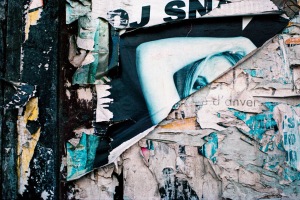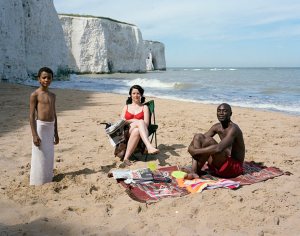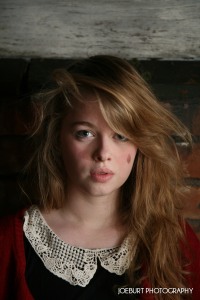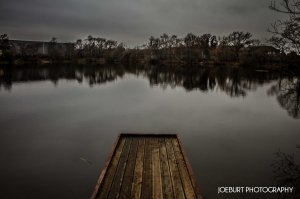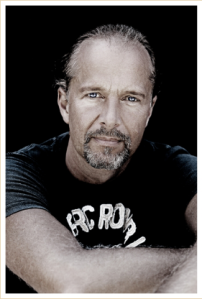Luckily my friend has a car and loves taking photos as much as I do, so we ventured out into Lincolnshire yesterday to photograph some picturesque areas in the flat county.
Our first stop was RAF Stenigot’s disused radio satellites. After driving through and around Stenigot for over half an hour we eventually spotted a small tower on the horizon, as we stopped to check directions, and of course we found the dishes in a farmers field next to the small tower, with a very easy entrance.
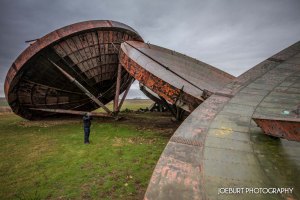
Demonstration of the immense size of the dishes.
Above you can see, in comparison to Tom, how large these dishes are. We both agreed it was an unreal feeling, and neither of us had experienced anything like this before. They were also a lot harder to photograph than expected, due to the huge size but also to the way they were sprawled out on the ground. When they became non-operational they were collapsed from their supports and landed on each other, which proved difficult to frame, but we made a few good shots before the farmer owning the land asked us to leave.
Our next target was RAF Nocton Hall. On our journey there we stumbled across two more personal points of interest, an open church and a derelict farmhouse.
St. George’s, Glotho, was a quaint church on a small hill overlooking the farm land of Lincolnshire.
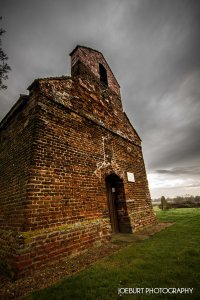
Not the usual sunny blue, but a moody sky adding a different tone.
The exterior featured deep red brickwork, perfectly contrasting with the green grass, but the interior was refurbished and painted grey. This restoration felt too modernised, personally, and didn’t feel like they’d kept it true it’s original state, apart from some old wooden pews upstairs of the building.
Continuing our journey to Nocton, we passed many farmhouses, but one caught our eye above the rest due to its dereliction.
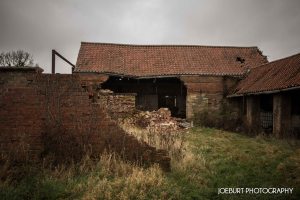
A dilapidated farmhouse still standing with minimal support
A bricked farmhouse half dilapidated with piles of rubble spread around. The buildings were so photogenic and this location turned out to be one of the most profitable of the day so far. As we searched the area for more photos we found a large building with a tractor in, and loads of large 600KG bags of Ammonium Nitrate. I later discovered that Ammonium Nitrate is explosive and is used in improvised explosive devices (IED’s).
Finally we arrived at Nocton, and to my surprise it was rather close to Lincoln. Tom and I had read online about having to park far away and it being a long walk in. False. We drove straight up to the hall and parked in the car park 10yds from the tree planted by King Henry VIII’s fifth wife, Katherine Howard, in 1541. It’s now held up by stilts.
We first photographed the RAF Nocton Hall hospital, which was in use between the 1940s-1984 when it was then leased to the USAF.
The grounds were immensely overgrown with trees everywhere, even growing through the windows of the buildings. The buildings themselves were rather vandalised, graffiti and walls smashed in by sledgehammers and axes. At first this seemed like a perfect opportunity for photos, and I seized it, but after a while my thoughts were that of ‘why would people vandalise places like this?’ The whole area we saw was amazing and I personally felt it was disrespectful that people felt the need to destroy a place that nursed Her Majesty’s troops back to health during WWII.
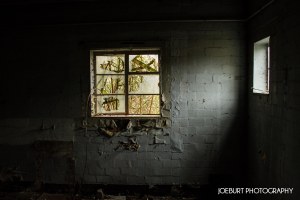
Just enough light from a window.
The first building we entered, we were not prepared at all as, an owl silently glided from the point we entered to the exit. It was a surreal moment for me and that image is now imprinted in my head forever, literally breathe taking.
We racked up a large amount of photos here, everything was so photogenic but it always felt like something was missing, almost as if the photos needed a subjet. Then we hit the jackpot. A building that looked hardly vandalised compared to the rest, it still had carpet in one section. The photos here felt a lot better in terms of capturing a moment, it led me to think and explore more with props in other projects, as props supply the audience with more questions.
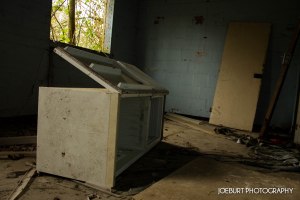
Fridge/freezer left behind
We then ventured back to Nocton Hall. The state of that building is in complete disrepair, it is nothing but a shell of walls, and no floors. We entered and could hardly move anywhere safely. We only ventured into a small area that still had a ceiling that I would assume was a basement area. Throughout the whole day, this was the only location I felt unsafe in, the fear of the one ceiling left coming down on us with the force of the other ceilings currently on top of it was not what I expected. Tom also mentioned this was probably the worst building he’d ever been in for its dereliction.
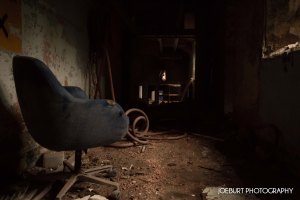
Perfect lighting for the mood of the building.
Although, the photos produced from Nocton Hall were stunning and the objects left behind that survived the fire in the 1980s proved excellent subjects for photographs.
All in all a successful day for photographs. To see more images from this day’s adventure click here.
